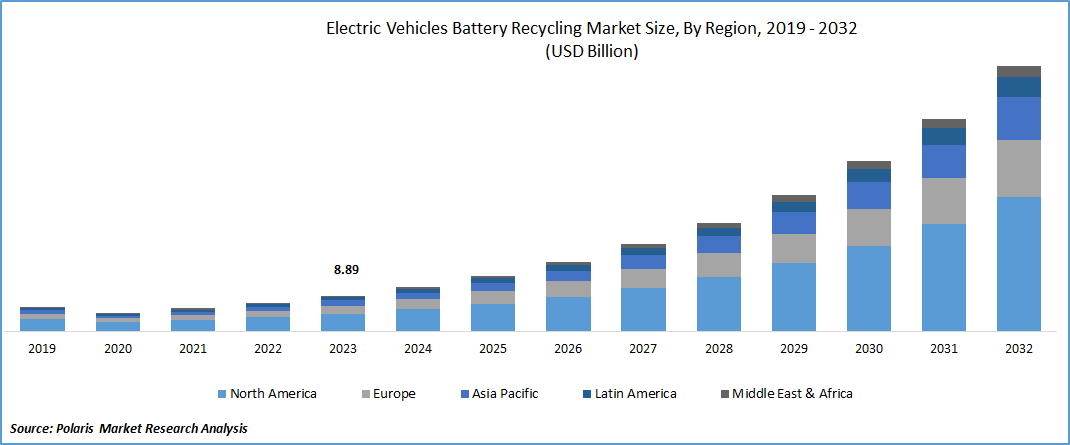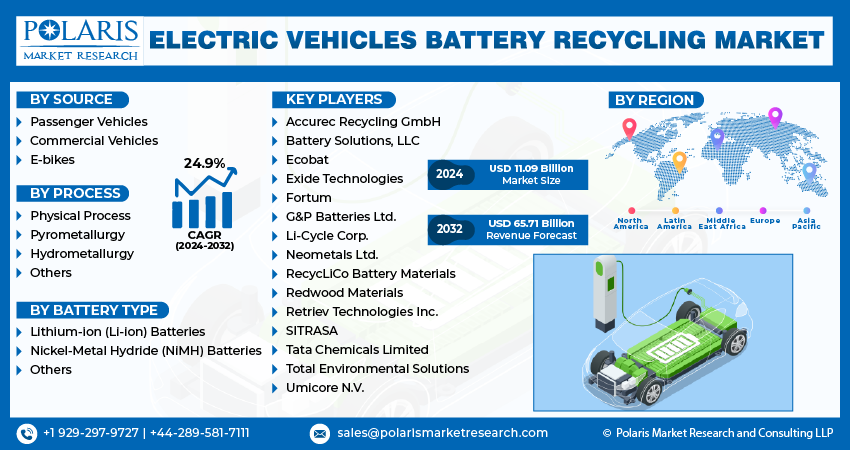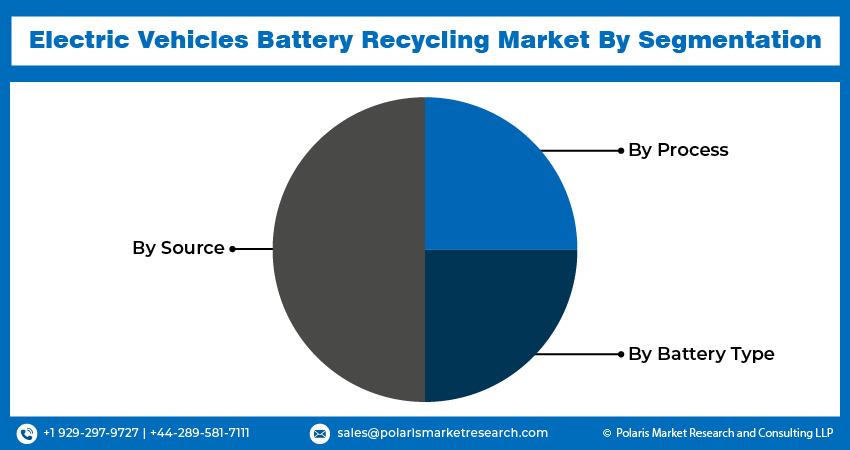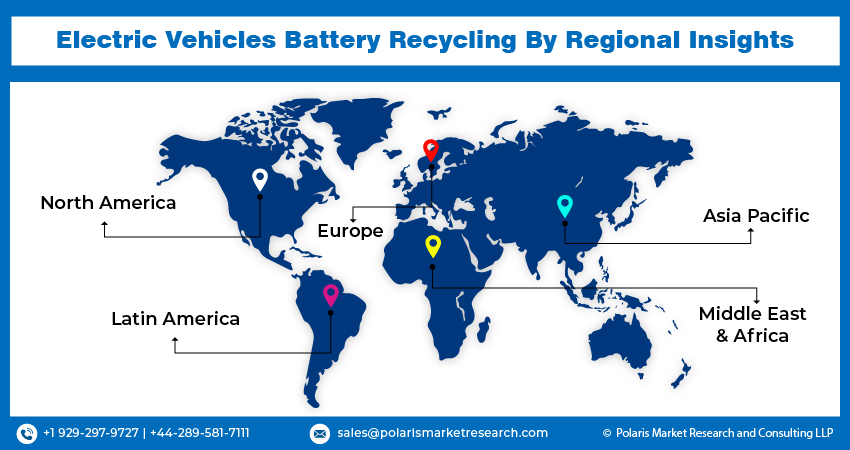
Electric Vehicles Battery Recycling Market Share, Size, Trends, Industry Analysis Report, By Source (Passenger Vehicles, Commercial Vehicles, E-bikes); By Process; By Battery Type; By Region; Segment Forecast, 2024- 2032
- Published Date:Apr-2024
- Pages: 118
- Format: PDF
- Report ID: PM4819
- Base Year: 2023
- Historical Data: 2019-2022
Report Outlook
Electric Vehicles Battery Recycling Market size was valued at USD 8.89 billion in 2023. The market is anticipated to grow from USD 11.09 billion in 2024 to USD 65.71 billion by 2032, exhibiting the CAGR of 24.9% during the forecast period.
Market Introduction
Circular economy initiatives are playing a pivotal role in accelerating the growth of the electric vehicles battery recycling market size. As the global shift towards sustainable practices intensifies, the focus on circularity in resource management becomes essential. Electric vehicle batteries, crucial components in the transition to cleaner transportation, present both opportunities and challenges in terms of end-of-life management. Circular economy principles advocate for the reuse, refurbishment, and recycling of materials to minimize waste and maximize resource efficiency. By recovering valuable materials such as lithium, cobalt, and nickel from spent batteries, these initiatives not only reduce environmental impacts but also contribute to the creation of a closed-loop system, driving innovation and investment in the EV battery recycling market.

To Understand More About this Research:Request a Free Sample Report
In addition, companies operating in the market are introducing new products to expand market reach and strengthen presence.
For instance, in October 2023, Stellantis N.V. and Orano collaborated by signing a memorandum of understanding to create a joint venture. This venture aims to recycle electric vehicle batteries and factory scrap from gigafactories across Enlarged Europe and North America.
Electric vehicles rely heavily on lithium-ion batteries, which contain essential materials like lithium, cobalt, and nickel. As the global demand for EVs escalates, so does the demand for these critical materials. However, the supply of these materials is finite and often concentrated in specific regions, leading to concerns about resource scarcity and geopolitical instability. In response, battery recycling emerges as a sustainable solution to recover and reuse these valuable materials. Recycling not only reduces reliance on primary sources but also minimizes environmental impact and promotes a circular economy.
Industry Growth Drivers
Rise in Electric Vehicle Adoption is Projected to Spur the Product Demand
The rise in electric vehicle (EV) adoption worldwide is catalyzing the expansion of the electric vehicle’s battery recycling market. As the demand for EVs surges, so does the need for battery recycling to manage end-of-life batteries responsibly. The lithium-ion batteries powering EVs contain valuable metals like lithium, cobalt, and nickel, prompting the development of recycling infrastructure to recover these resources. Additionally, recycling helps mitigate environmental impact by reducing the need for raw material extraction and minimizing waste. Governments and manufacturers are increasingly investing in battery recycling technologies and processes to meet sustainability goals and ensure a circular economy for EV batteries.
Environmental Regulations and Sustainability Goals are Expected to Drive Electric Vehicles Battery Recycling Market Growth
Environmental regulations and sustainability goals are propelling the growth of the electric vehicles battery recycling market share. Governments worldwide are tightening emissions standards and setting ambitious sustainability targets, leading to increase in demand for eco-friendly transportation solutions like electric vehicles. Recycling these batteries not only mitigates the environmental impact of hazardous materials but also addresses concerns regarding resource depletion and supply chain sustainability. Stringent regulations and sustainability initiatives drive investment and innovation in battery recycling technologies and infrastructure, creating a robust market for sustainable battery management solutions in the electric vehicles sector.

Industry Challenges
Lack of Regulatory Frameworks is Likely to Impede the Market Growth
The electric vehicles battery recycling market trends faces limitations due to the lack of regulatory frameworks. While the demand for electric vehicles and their associated batteries continues to rise, there is a notable absence of comprehensive regulations governing the recycling and disposal of these batteries. This absence creates uncertainty and inconsistency in recycling practices across different regions, hindering the development of a standardized and efficient recycling infrastructure. Without clear guidelines and incentives, stakeholders may lack the motivation to invest in battery recycling technologies and processes. Additionally, the lack of regulations can lead to improper disposal practices, posing environmental risks and resource wastage.
Report Segmentation
The electric vehicles battery recycling market analysis is primarily segmented based on source, process, battery type, and region.
|
By Source |
By Process |
By Battery Type |
By Region |
|
|
|
|
To Understand the Scope of this Report:Speak to Analyst
By Source Analysis
Passenger Vehicles Segment Held Significant Revenue Share in 2023
The passenger vehicles segment held significant revenue share in 2023. With the rapid growth in electric vehicle adoption, fueled by environmental concerns and government incentives, the need for battery recycling within this segment is escalating. Additionally, as electric vehicle batteries reach their end-of-life, there is a consistent demand for recycling services. Moreover, consumer awareness regarding environmental impact and regulatory pressures further contribute to the segment's dominance in the electric vehicles battery recycling market analysis.
By Process Analysis
Hydrometallurgy Offers Advantages Such as Efficiency, Selective Extraction, Reduced Emissions, and Scalability
Hydrometallurgy presents numerous advantages in the market. Its efficiency enables the extraction of valuable metals like lithium, cobalt, nickel, and manganese from spent batteries, maximizing resource recovery. Selective extraction ensures the retrieval of high-purity materials suitable for reuse in battery manufacturing. Environmentally friendly processes, with lower energy consumption and emissions compared to traditional methods, make it a sustainable option. Versatility allows for handling various battery chemistries, while scalability accommodates operations of all sizes.
By Battery Type Analysis
Lithium-Ion Batteries Segment Held Significant Revenue Share in 2023
The lithium-ion batteries segment held significant revenue share in 2023. Their widespread use in electric vehicles drives growth. Their longevity and durability result in a substantial volume of batteries available for recycling. Additionally, their high energy density makes them ideal for EVs with longer driving ranges, further bolstering demand. Moreover, these batteries contain valuable materials like lithium, cobalt, and nickel, incentivizing recycling efforts. Environmental regulations and consumer awareness also contribute to their prominence, emphasizing the need for responsible disposal and recycling practices.

Regional Insights
Asia-Pacific Region Accounted for a Significant Market Share in 2023
In 2023, Asia-Pacific region accounted for a significant market share. High electric vehicle adoption rates in countries like China, Japan, and South Korea contribute to substantial demand for battery recycling. As a manufacturing hub for electric vehicles and batteries, the region generates a considerable volume of end-of-life batteries. Additionally, supportive government policies and incentives, coupled with growing environmental awareness, drive the adoption of sustainable practices like battery recycling. Furthermore, substantial investments in recycling infrastructure and technologies by governments and businesses further solidify the region's dominance in the electric vehicle battery recycling market.
The market in Europe is driven by stringent government regulations mandating responsible disposal and recycling of EV batteries. The region's rapid adoption of electric vehicles has led to a surge in end-of-life batteries, necessitating efficient recycling infrastructure. Emphasizing resource efficiency and waste reduction, the EU's circular economy initiatives promote the development of a robust recycling ecosystem. Collaboration among automotive manufacturers, battery producers, and recycling companies fosters innovation and investment in recycling technologies. Additionally, increased green investment, supported by government incentives, fuels market growth.

Key Market Players & Competitive Insights
The electric vehicles battery recycling market involves a diverse array of players, and the expected arrival of new contenders is poised to intensify rivalry. Established leaders continuously enhance their technologies to maintain a competitive advantage, emphasizing effectiveness, reliability, and safety. These firms prioritize strategic actions such as establishing collaborations, improving product portfolios, and participating in cooperative endeavors. Their aim is to outperform competitors within the field, securing a significant electric vehicles battery recycling market share.
Some of the major players operating in the global market include:
- Accurec Recycling GmbH
- Battery Solutions, LLC
- Ecobat
- Exide Technologies
- Fortum
- G&P Batteries Ltd.
- Li-Cycle Corp.
- Neometals Ltd.
- RecycLiCo Battery Materials
- Redwood Materials
- Retriev Technologies Inc.
- SITRASA
- Tata Chemicals Limited
- Total Environmental Solutions
- Umicore N.V.
Recent Developments
- In January 2024, BASF and Stena Recycling entered a collaboration to establish a complete battery recycling value chain for Europe's electric vehicle battery sector.
- In December 2023, LOHUM Cleantech announced its expansion into the UAE market, where it plans to construct the country's first EV Battery Recycling plant. This project is the result of a partnership agreement with the Ministry of Energy & Infrastructure, UAE, and BEEAH, a pioneer in sustainability and digitalization in the Middle East.
Report Coverage
The electric vehicles battery recycling market report emphasizes on key regions across the globe to provide better understanding of the product to the users. Also, the report provides market insights into recent developments, trends and analyzes the technologies that are gaining traction around the globe. Furthermore, the report covers in-depth qualitative analysis pertaining to various paradigm shifts associated with the transformation of these solutions.
The report provides detailed analysis of the market while focusing on various key aspects such as competitive analysis, sources, processes, battery types, and their futuristic growth opportunities.
Electric Vehicles Battery Recycling Market Report Scope
|
Report Attributes |
Details |
|
Market size value in 2024 |
USD 11.09 billion |
|
Revenue forecast in 2032 |
USD 65.71 billion |
|
CAGR |
24.9% from 2024 – 2032 |
|
Base year |
2023 |
|
Historical data |
2019 – 2022 |
|
Forecast period |
2024 – 2032 |
|
Quantitative units |
Revenue in USD billion and CAGR from 2024 to 2032 |
|
Segments covered |
|
|
Regional scope |
|
|
Competitive Landscape |
|
|
Report Format |
|
|
Customization |
Report customization as per your requirements with respect to countries, region, and segmentation. |
FAQ's
Electric Vehicles Battery Recycling Market report covering key segments are source, process, battery type, and region
Electric Vehicles Battery Recycling Market Size Worth $ 65.71 Billion By 2032
Electric Vehicles Battery Recycling Market exhibiting the CAGR of 24.9% during the forecast period.
Asia-Pacific is leading the global market
The key driving factors in Electric Vehicles Battery Recycling Market are Rise in electric vehicle adoption is projected to spur the product demand
